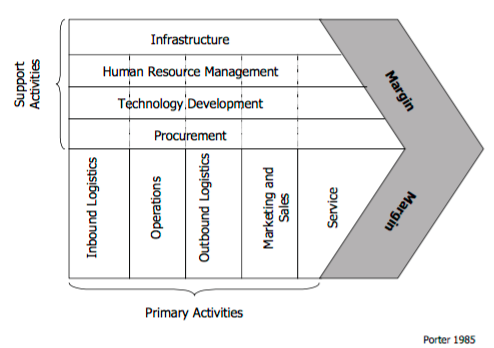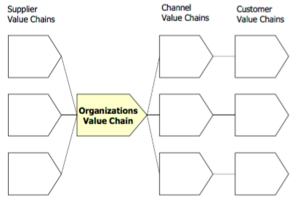Value Chain Analysis
(→Organisations Value Chain) |
|||
| Line 27: | Line 27: | ||
===Organisations Value Chain=== | ===Organisations Value Chain=== | ||
[[File:Organisation value chain.png|right|300px]] | [[File:Organisation value chain.png|right|300px]] | ||
| − | In most industries, the activities of the value chain, from product design, production of components, and final assembly to delivery to the final user, are not all handled by the company. Organisations are, as a result, part of a value system | + | In most industries, the activities of the value chain, from product design, production of components, and final assembly to delivery to the final user, are not all handled by the company. Organisations are, as a result, part of a value system or supply chain. When analyzing the value chain, it is important to consider the one of the whole value system the chain is embedded in. |
| − | Within the whole value system, only a certain part of profit margin is available to the company. As stated previously, the profit margin is the difference of the final price the customer pays and the sum of all costs incurred with the production and delivery of the product/service. It depends on how the value system is structured, how this margin spreads across the suppliers, producers, distributors, customers, and other elements of the value system. Each organization in the system will negotiate and use its market position to get a higher share of the margin. However, collaborations and cooperation can be encouraged if there is the opportunity for both companies to improve their efficiency and reduce their costs. The result is to achieve a higher total margin that benefits of all of them. An example is reducing stocks in a Just-In-Time system. | + | Within the whole value system, only a certain part of profit margin is available to the company. As stated previously, the profit margin is the difference of the final price the customer pays and the sum of all costs incurred with the production and delivery of the product/service. It depends on how the value system is structured, how this margin spreads across the suppliers, producers, distributors, customers, and other elements of the value system. Each organization in the system will negotiate and use its market position to get a higher share of the margin. However, collaborations and cooperation can be encouraged if there is the opportunity for both companies to improve their efficiency and reduce their costs. The result is to achieve a higher total margin that benefits of all of them. An example is reducing stocks in a Just-In-Time system.<ref name=two>www.themanager.org, Dagmar Recklies, 2001 |
| + | Recklies Management Project GmbH < /ref> | ||
===Industry Application=== | ===Industry Application=== | ||
Revision as of 20:51, 26 September 2016
The term Value Chain is one of Michael Porter most famous concept along the five forces. It was introduced in his book "Competitive Advantage: Creating and Sustaining superior Performance" (1985). An analysis of the value chain both describes the activities of an organization and links them to the competitive position of the organization. This analysis results in identifying the activities that are a source of cost or lead to a differentiation advantage and those that could improve the competitive advantage of the company or of the project. This tool helps companies designing viable products or services at the right price.
Contents |
The Concept
Value chain analysis describes the activities in and around an organization and links them to an analysis of competitive strength of the organization. The analysis assesses which value every specific activity adds to the organisations products or services. This thought was based upon the knowledge that an organisation is more than an arbitrary gathering of machine, equipment, people and money. In order to produce something the customers are willing to pay for, these things have to be arranged into systems and systematic activities. According to Michael Porter, the ability of an organization to perform certain activities and to manage the linkages between those activities is through which competitive advantage can be gained.[1]
Porter differentiates between two sets of activities. All activities that are directly related to the creation or delivery of a product or service are called primary activities and support activities are those activities that are linked to each primary activity that tries to improves its efficiency and effectiveness.[1]
Primary Activities
- Inbound Logistics: all activities associated with the receiving, distributing and storing of incoming materials
- Operations: converting inputs (raw materials, energy and labor) into outputs (the final product/service)
- Outbound Logistics: all activities associated with the storage and movement of the final product to the end user
- Marketing and Sales: all activities involved in the assessment and encouragement of customers to purchase and the activities associated in providing a medium to purchase the product
- Service: activities related to the maintenance and enhancement of value to the end user after the product is sold
Secondary Activities
- Procurement: the acquisition of goods or services from an external source
- Human Resource Management: all activities associated with the management of people as per the requirements
- Technology Development: all activities related to the equipment, hardware, software, technical knowledge and procedures to transform the inputs into outputs
- Infrastructure: all other activities including legal, finance, accounting, public relations and quality assurance
Margin
The term Margin refers to the profit margin the company makes out of the activities of its value chain.[1] The margin is correlated with the company’s ability to articulate properly all the activities of the value chain. A high margin means the company is able to sell a product or a service for a much higher price than the cost of all the activities of the value chain. The linkages are flows of information, goods, services, and systems or processes adjusting activities.[1] Here are some examples to get a better idea of their importance. If the marketing & sales activities provide sales forecasts for the next period to all other departments reliable and on time, procurement will be able to order the right material for the correct date. Following this reasoning, if procurement forwards the orders to inbound logistics, then operations will be able to schedule production in order to forwarded it to the outbound logistics and guarantee the delivery of the products on time, meaning as expected by marketing & sales. This is why linkages are extremely important and represent the cooperation and information flow between the value chain activities needed to run the activities.
Organisations Value Chain
In most industries, the activities of the value chain, from product design, production of components, and final assembly to delivery to the final user, are not all handled by the company. Organisations are, as a result, part of a value system or supply chain. When analyzing the value chain, it is important to consider the one of the whole value system the chain is embedded in. Within the whole value system, only a certain part of profit margin is available to the company. As stated previously, the profit margin is the difference of the final price the customer pays and the sum of all costs incurred with the production and delivery of the product/service. It depends on how the value system is structured, how this margin spreads across the suppliers, producers, distributors, customers, and other elements of the value system. Each organization in the system will negotiate and use its market position to get a higher share of the margin. However, collaborations and cooperation can be encouraged if there is the opportunity for both companies to improve their efficiency and reduce their costs. The result is to achieve a higher total margin that benefits of all of them. An example is reducing stocks in a Just-In-Time system.[2]
Cite error:
<ref> tags exist, but no <references/> tag was found

